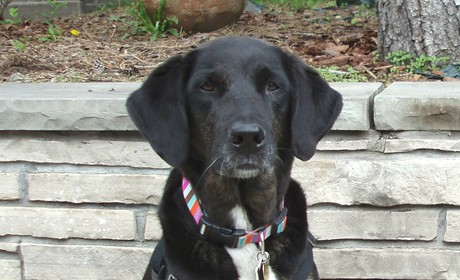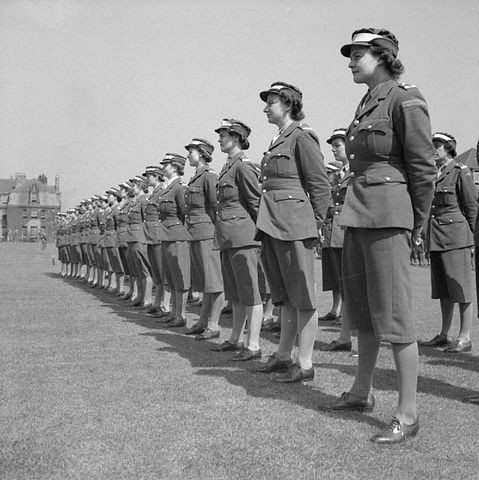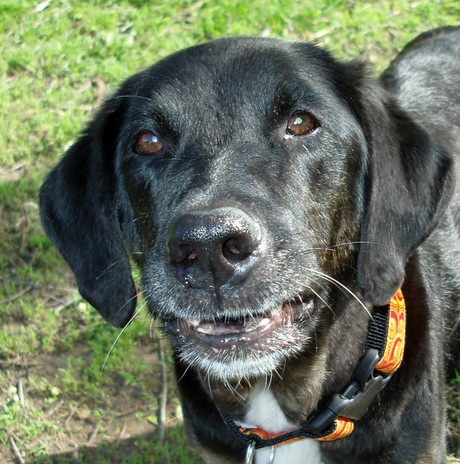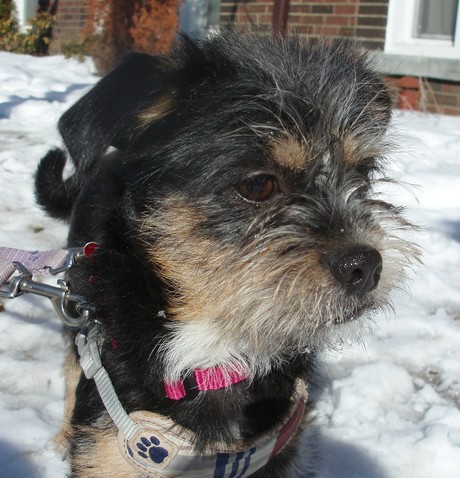When can I get mad at my dog?

Don't be fooled: Obie is a handful.
I told my friend Kim that I was writing a post exploring when we can get mad at our dogs. "All the time," she said promptly. Kim has a very large 7 month old puppy, Obie, who oscillates between rambunctiously leaping at life and stubbornly refusing to move.
"No, no," I clarified. "Not when do we get mad, but when can we? When are we allowed to? Is it ever OK?" I try not to get annoyed with my dogs. Sometimes I have to draw a large, red 'C' on my hand: 'C' for calm, 'C' for cheerful — not, as my dogs think, 'C' for cranky.
You may have noticed that sternly 'no'-ing the dog is a big faux pas these days; positive reinforcement training (PRT) is all the rage. Probably rage is not the best metaphor, since PRT's hallmarks are encouragement and rewards. Physical and psychological intimidation are strictly verboten. I first came across PRT a few years ago, not because I was sold on its methods — I had no idea what they were — but because I was looking for ways to cheer up my dog, the depressed, skittish, then ten-year old Foo Fighter.
I wasn't interested in training for obedience; Foo was already entirely too biddable. Once, asked to 'drop' a mystery object while on a walk, Foo forked over a big piece of bacon. The pack and I were appalled. Who gives up bacon in exchange for approval? A dog who lacks self-confidence, that's who. Those were the thoughts pre-PRT, anyway.

Foo, in morose mode.
I chose a training company called 'Up With Pup,'* mostly because its name matched my anti-depressant objectives. The buoyant, treat-packing Sean arrived on our doorstep. Foo was less than thrilled, at first. She was reluctant to try new stuff; she'd learned to execute a mind-melding 'look' (holding eye-to-eye contact) in her anxious youth, and 'look' was all she really wanted to do. But, under the influence of Sean's expert enthusiasm, Foo slowly mastered a bunch of novel, useless skills: nose nudging soccer balls, going under or over obstacles, and leaping on tables. (The table trick was my idea, not Sean's, and for a while Table Top Dancer Foo was jumping unbidden on any table, anywhere, at any time).
Sean taught me to use a perky, high-pitched, rapturous tone of voice, which I explained to my incredulous friends was "the cookie voice," since treats usually fell from the sky during training sessions. Showered with praise and treats, Foo got a happy energy buzz and increased self-confidence. I, in turn, got to learn what a delicate flower Foo really was, and how to build a better rapport with all dogs, especially the shrinking-violet variety.
I also gleaned some of the general principles of PRT: good behaviours are rewarded and 'unwanted' ones are ignored or redirected, 'no' is usually a no-no, and displays of human vexation may result in an unhappy and unbalanced canine.
Before Up With Pup got me in its clutches, I had been generous with treats, but tended to snap out my commands. Possibly this was because I grew up with a mother a lot like Captain von Trapp, minus the guitar strumming (she had a zippy Baroness side, too, but the Captain made a deeper impression). So even after my intro to PRT, I struggled with imperiousness, especially when it came to training McCracken, a new pup who had joined the home pack.

I suspect I come from a long line of militant females.
Fairly frequently, I wanted to yell at McCracken. PR trainers assume that yelling for us humans is 'no fun', but this may be akin to saying barking for dogs is no fun: stressed-out expression of helplessness, or self-soothing, self-reinforcing behaviour? You decide. In any case, teaching Mack Crack to 'Drop!' using positive reinforcement methods did not prevent him from wolfing down every stick in the ravine. Foo's easy surrender of bacon was now, in retrospect, looking pretty good.
Exasperated, I asked Sean, "Well, when can I say no? When can I get mad at him?" I knew there was no way I would not be pissed off (notice all the negatives in this very sentence). Most likely it would be at 3 a.m., when McCracken's wood up-chucking usually commenced. Was there any space in PRT for human hissy fits? Or even a steely 'no'? I had noticed that Sean never said "no!" or "wrong!" to either me or the dogs. In fact, he ignored or redirected all my negativity, just as he did any shenanigans from the dogs.
So I wasn't overly shocked when, in response to my direct question about nixing the sticks, Sean warned me against using 'no.' Also, I was not to say 'no' to McCracken when we flubbed a training exercise. And I should not loose my cool when McCracken, confronting unfamiliar dogs, had barking, lunging meltdowns. If I got mad — which I shouldn't — McCracken's snarling needed to be well under way, the positive techniques tried and failed, before I expressed disapproval. "You can lose it after he's lost it, if you must," said Sean. While empathetic, he looked disappointed by my need to blow my stack. He looked quite negative about it, in fact.

Foo, the happy camper, post PRT.
And of course, Sean was right: with Mack Crack, upbeat enthusiasm usually gets his attention, while NO! escalates his hysteria every time. But there's a problem. For a 45 minute class I, like most people, can pull off a pretty good Pollyanna impression. Then it's back to real life, when feelings of minor peevishness or real rage (find your place on the spectrum) spill out, usually in a 'This is not OK!' or an 'I can't stand this!' moment.
Of course such crabbiness should be suppressed for the sake of the dogs, especially the sensitive ones, but — to be selfish for a nano-second — what about what's best for me (and, by arrogant extension, all cranky humans)? Won't the stress of constant niceness make us keel over from hypertension?
To find out, I did a little on-line, cherry-picking research into human anger. First, cancel my reference to "all cranky humans". According to social scientists, factors like cultural background, class, gender identification, health status and race/ racialization shape our experience of anger and its consequences for our health. That said, some insights from biochemistry and neuroscience may be generally applicable.
It turns out that while anger does increase our heart rate, blood pressure, and testosterone, it decreases the stress hormone cortisol. And it activates our left brain, stimulating approach (vs. avoidance) behaviours. Scientists speculate that anger primes us to deal with a problem, rather than run from it. So getting mad at the dog might be the first step in solving a behaviour problem.
If feeling mad has its advantages, what about expressing it? Sadly for drama queens, the cathartic expression of anger only escalates our stress and aggression. So no more primal screams, pummelling pillows, or yelling at dogs. However, the complete suppression of anger is also a no-go, as there's a tendency to turn anger against the self. Many scientists suggest a moderate middle path, speculating that "anger is probably good for you" as long as you "keep the flame low."
Personally, I feel a lot like McCracken, who can keep his shit together, with PR help, for an hour and half walk, only to have three meltdowns in the homestretch. (There's a term for this, "self control depletion," a phenomenon experienced by both humans and dogs.) To prevent outbursts at my end of the leash, I try to keep my anger flame low, as the experts advise, but let it burn nonetheless.
This involves a lot of one-way communication with the dogs, in ways that let off steam without blowing a gasket. Here are the kind of comments I'm prone to make:
- "Let's see if we can get home without me killing anyone, including myself."
- "That was NOT your finest hour." (McCracken thinks this is his mantra, he hears it so often).
- "Fuck off, sweetie pie!" (and other curse/endearment combos).
- "Everyone relax, especially me."
I find the low flame approach helps me maintain my sangfroid. And I've also learned that the all-positive-all-the-time approach, while in their long term best interest, is not necessarily most effective strategy for every dog.

Pushkin and I are negotiating on how best to handle the growling.
McCracken, as mentioned, requires a cheerleader during stressful moments; anything less than complete enthusiasm and a fistful of treats makes his eyeballs roll back in his head. The hyper-excited Notley, however, does better with a short repressive 'no' or 'leave it,' as long as the command is delivered without eye contact. This calms her down — or subdues her spirit, depending on your interpretation — and she can then focus on instructions, always issued in an upbeat, cheerful tone with eye contact, followed by a reward. (This only took me a year and a half to figure out.) Pushkin, the one year old, is still a work-in-progress, taking notes on her siblings' routines. She's a terrier, so she favours growling a lot, unless preemptively distracted.
Despite these variations, we are all less querulous since I've adopted the (often fake) perky voice and positive approach. Fake it till you make it, I guess. One thing for sure is that when 'no' has a privileged place in the training toolbox, we overuse it. Enter almost any home with a puppy and prepare to hear an avalanche of 'no's. I once observed a client yelling 'no, no, no' at a puppy who was in another room — the person couldn't actually see what the pup was doing. "Maybe wait and see if he's doing something wrong before yelling," I suggested helpfully.
Pre-positive reinforcement, I had to use a fierce, 'death is around the corner' voice when I needed the dogs to stop any dicey or dangerous behaviour. Now they respond to the mildest of warning tones. Of course, they respond even quicker to a positive command issued in the crazy-praisey tone of voice that I learned from Up With Pup — when I remember to use it.
*Sean is now a partner in Wildflower Dog training: http://wildflowerdog.ca/.
Kikopup's manifesto on PRT (here called Progressive Reinforcement Training):
https://dogmantics.com/progressive-reinforcement-training-manifesto/english-manifesto/
Some mainstream journalism regarding PRT:
https://www.psychologytoday.com/blog/canine-corner/201205/is-punishment-effective-way-change-the-behavior-dogs
http://www.telegraph.co.uk/lifestyle/pets/10716677/The-dog-training-methods-which-leave-your-pet-stressed.html
Patricia McConnell's advice on teaching a dog what not to do:
http://www.patriciamcconnell.com/sites/default/files/Bark%202007%20Jan-Feb%20Behavior%20Interruptus.pdf
On self-control depletion (in dogs and people):
http://www.patriciamcconnell.com/theotherendoftheleash/self-control-depletion-dogs
Psychology Today's take on anger: https://www.psychologytoday.com/articles/201403/go-forth-in-anger
Want to make a comment and avoid registering with Disqus? Click on 'join the discussion' and in the name field at the bottom of the form check "I'd rather post as a guest." A name and email address are still required.